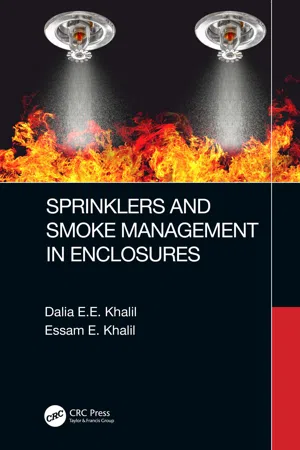
- 146 pages
- English
- ePUB (mobile friendly)
- Available on iOS & Android
Sprinklers and Smoke Management in Enclosures
About this book
This book addresses smoke management in enclosures and provides a platform for understanding the principles of smoke propagation and spread, heat release rate, and the effect of sprinklers on suppression. Considering how sprinkler systems have become a vital part of firefighting systems in enclosures, the book evaluates the effect of sprinkler activation on the behavior of fire-induced smoke and the interaction of water particles with the smoke layer. It studies two base case models where the sprinklers' effect on the fire curve was considered. This base case was assessed with two smoke extraction systems, namely, a ducted system and an impulse ventilation system. By focusing on key elements, such as visibility, ceiling height, and fire curve, the results of the study will be of interest to mechanical engineers, HVAC professionals, and fire safety professionals and investigators.
Features
- Includes case models and scenarios to evaluate real examples from different applications
- Studies the effect of sprinkler activation on the behavior of fire-induced smoke
- Explores various factors, such as ceiling height, sprinkler operating pressure, and fire curve
- Discusses the interaction of water particles with the smoke layer
- Utilizes Pyrosim software for CFD modeling
Frequently asked questions
- Essential is ideal for learners and professionals who enjoy exploring a wide range of subjects. Access the Essential Library with 800,000+ trusted titles and best-sellers across business, personal growth, and the humanities. Includes unlimited reading time and Standard Read Aloud voice.
- Complete: Perfect for advanced learners and researchers needing full, unrestricted access. Unlock 1.4M+ books across hundreds of subjects, including academic and specialized titles. The Complete Plan also includes advanced features like Premium Read Aloud and Research Assistant.
Please note we cannot support devices running on iOS 13 and Android 7 or earlier. Learn more about using the app.
Information

1
Introduction
1.1 Sprinklered Car Parks

Suppression system effectiveness [3].
1.2 Smoke Control
Table of contents
- Cover
- Half Title
- Title Page
- Copyright Page
- Table of Contents
- Preface
- Acknowledgments
- List of Abbreviations and Symbols
- Authors
- Appendix
- References
- Index